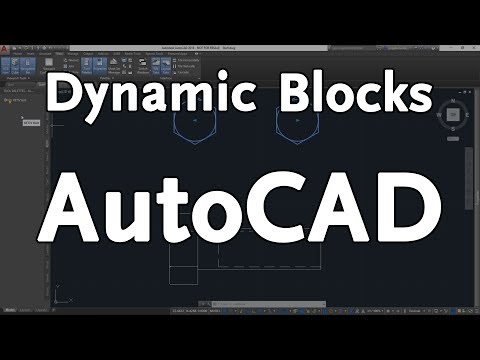Unleashing Design Potential: A Comprehensive Guide to Creating Dynamic Blocks and Refining 2D Models in AutoCAD

Introduction:
In the dynamic realm of Computer-Aided Design (CAD), AutoCAD has long been the cornerstone for architects, engineers, and designers seeking precision and efficiency. Among the array of powerful features, the creation of dynamic blocks and the refinement of 2D models stand out as transformative tools. This extensive guide aims to delve into the intricacies of creating dynamic blocks, exploring their functionalities, applications, and the profound impact they have on refining 2D models within AutoCAD.
Section 1: Understanding the Power of Dynamic Blocks
1.1 Dynamic Blocks Defined: Dynamic blocks in AutoCAD are intelligent, parametric components that allow for the creation of versatile, reusable design elements. Unlike traditional static blocks, dynamic blocks adapt to various configurations, enabling users to manipulate their geometry, visibility, and properties dynamically.
1.2 Parametric Design: Delve into the concept of parametric design within dynamic blocks. Understand how parameters and actions define the behavior of dynamic blocks, offering flexibility and efficiency in adapting designs to different requirements.
Section 2: Creating Dynamic Blocks in AutoCAD
2.1 Dynamic Block Editor: Learn how to access the Dynamic Block Editor in AutoCAD, the dedicated workspace for creating and editing dynamic blocks. Explore the interface and tools available within the editor for precise control over block parameters and actions.
2.2 Defining Parameters: Explore the process of defining parameters within dynamic blocks. Understand how parameters establish the variables that users can modify, such as lengths, angles, and visibility states, influencing the dynamic behavior of the block.
Section 3: Implementing Actions in Dynamic Blocks
3.1 Action Types: Delve into the various types of actions available in dynamic blocks. From linear and polar parameters to flip and rotate actions, understand how actions drive the dynamic behavior of the block based on user inputs.
3.2 Customizing Actions: Learn how to customize actions within dynamic blocks. Explore the options for setting constraints, specifying grips, and configuring the behavior of actions to create a seamless and intuitive user experience.
Section 4: Building Dynamic Block Libraries
4.1 Organizing Dynamic Blocks: Explore strategies for organizing dynamic blocks within libraries. Understand how to categorize and name blocks systematically for efficient retrieval and reuse across different projects.
4.2 Creating Tool Palettes: Learn how to create custom tool palettes for dynamic blocks. Understand the process of populating palettes with frequently used dynamic blocks, streamlining the insertion process and enhancing productivity.
Section 5: Applying Dynamic Blocks in 2D Models
5.1 Dynamic Blocks in 2D Drawings: Explore the application of dynamic blocks in 2D drawings. Learn how to insert dynamic blocks into your drawing, manipulate their parameters, and observe the real-time changes in geometry and appearance.
5.2 Enhancing Efficiency with Dynamic Blocks: Understand how dynamic blocks enhance efficiency in 2D modeling. From creating furniture layouts to refining electrical schematics, dynamic blocks streamline repetitive tasks and allow for quick design modifications.
Section 6: Refining 2D Models with Dynamic Blocks
6.1 Customizing Annotation in Dynamic Blocks: Explore how dynamic blocks can be utilized to customize annotation and text within 2D models. Learn how to create intelligent labels that adjust dynamically based on the block’s parameters.
6.2 Scaling and Dynamic Blocks: Understand the role of scaling in dynamic blocks. Explore techniques for incorporating dynamic scaling within 2D models, allowing for easy adjustments to accommodate different drawing scales and presentation needs.
Section 7: Advanced Techniques and Tips
7.1 Nested Dynamic Blocks: Delve into advanced techniques involving nested dynamic blocks. Explore how nesting dynamic blocks within other dynamic blocks adds layers of flexibility and complexity to your designs.
7.2 Parameter Sets and Grips: Learn about parameter sets and grips within dynamic blocks. Understand how parameter sets allow for the grouping of related parameters, and grips provide an intuitive interface for users to interact with dynamic blocks.
Section 8: Challenges and Troubleshooting
8.1 Common Challenges in Dynamic Block Creation: Address common challenges encountered when creating dynamic blocks. From unexpected behaviors to parameter conflicts, gain insights into effective problem-solving strategies.
8.2 Troubleshooting Tips: Explore troubleshooting tips for resolving issues related to dynamic blocks in 2D models. From alignment errors to unexpected scaling, understand how to maintain control and precision in your designs.
Section 9: Collaboration and Dynamic Blocks
9.1 Sharing Dynamic Blocks in Collaborative Workflows: Understand how to share dynamic blocks in collaborative workflows. Explore techniques for collaborating with team members, ensuring consistent usage of dynamic blocks, and maintaining design integrity.
9.2 External References (Xrefs) and Dynamic Blocks: Explore the integration of external references (Xrefs) with dynamic blocks. Learn how Xrefs can be utilized to enhance collaboration, allowing team members to work on specific sections of a drawing while maintaining dynamic block functionality.
Conclusion:
As we conclude this exhaustive exploration of creating dynamic blocks and refining 2D models in AutoCAD, it becomes evident that these features are pivotal in unleashing design potential and efficiency within the CAD environment. Whether you are a novice seeking to enhance your drafting skills or a seasoned professional navigating complex projects, mastering dynamic blocks transforms your design approach. Embrace the flexibility, customization options, and collaborative potential that dynamic blocks bring to your AutoCAD workflow, and witness how these fundamental elements elevate your designs from static drawings to intelligent, parametric representations. With continuous practice, exploration, and innovation, you will navigate the intricate landscape of 2D modeling with confidence, producing drawings that stand as testaments to the power of dynamic blocks in AutoCAD.




